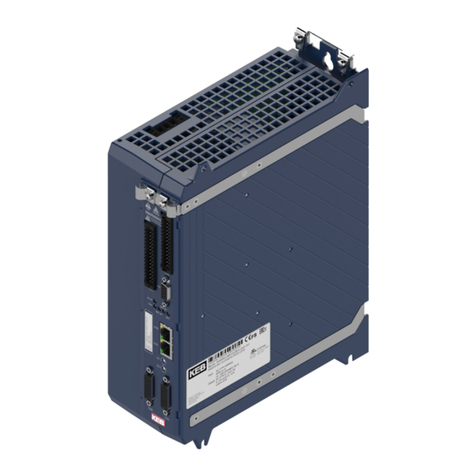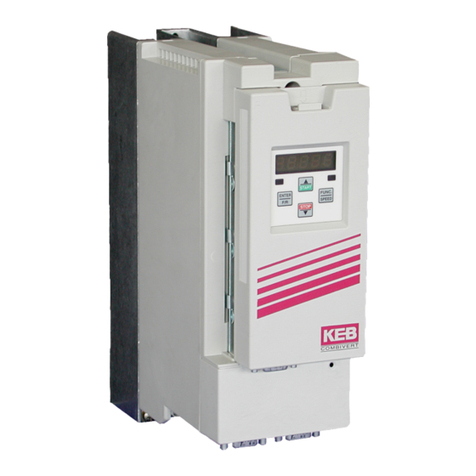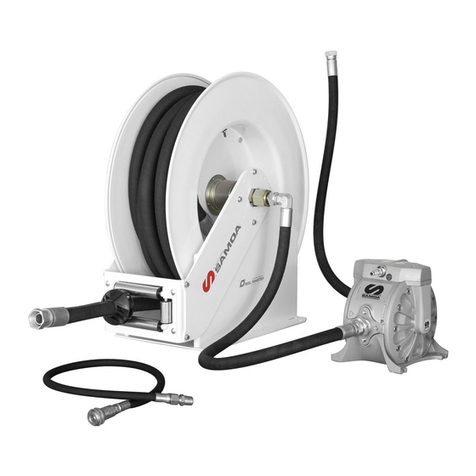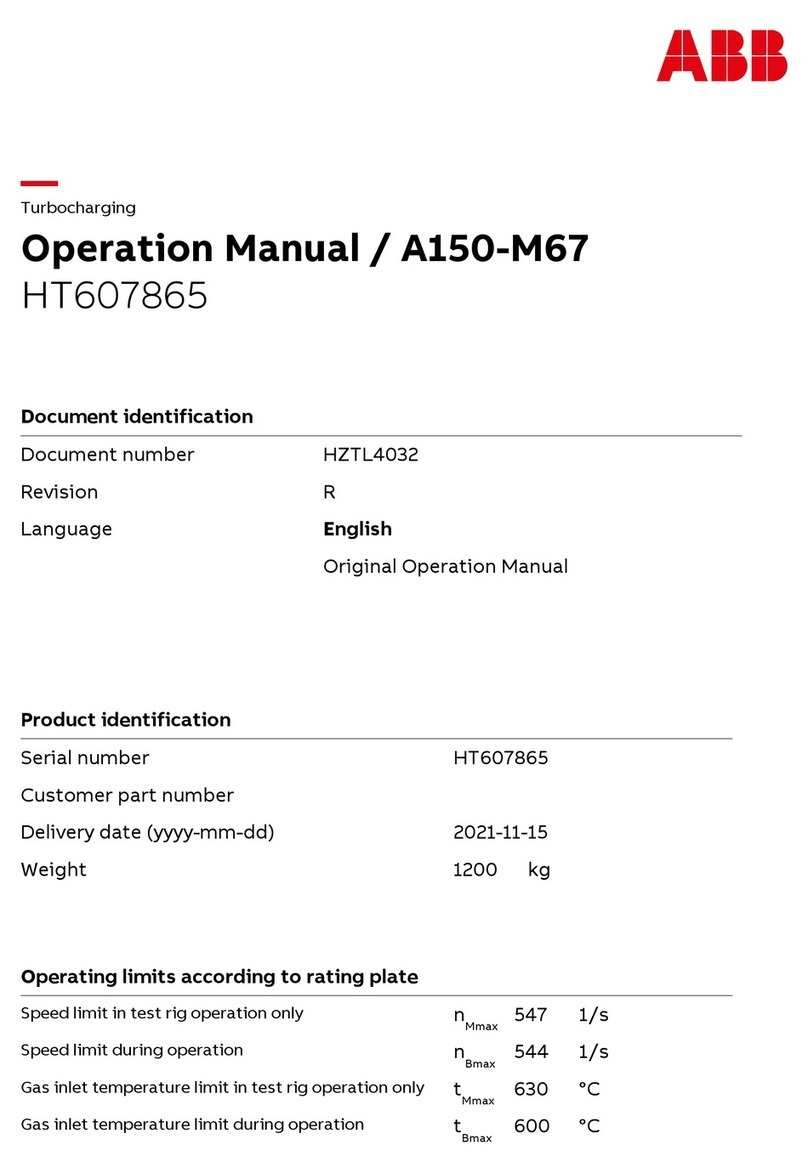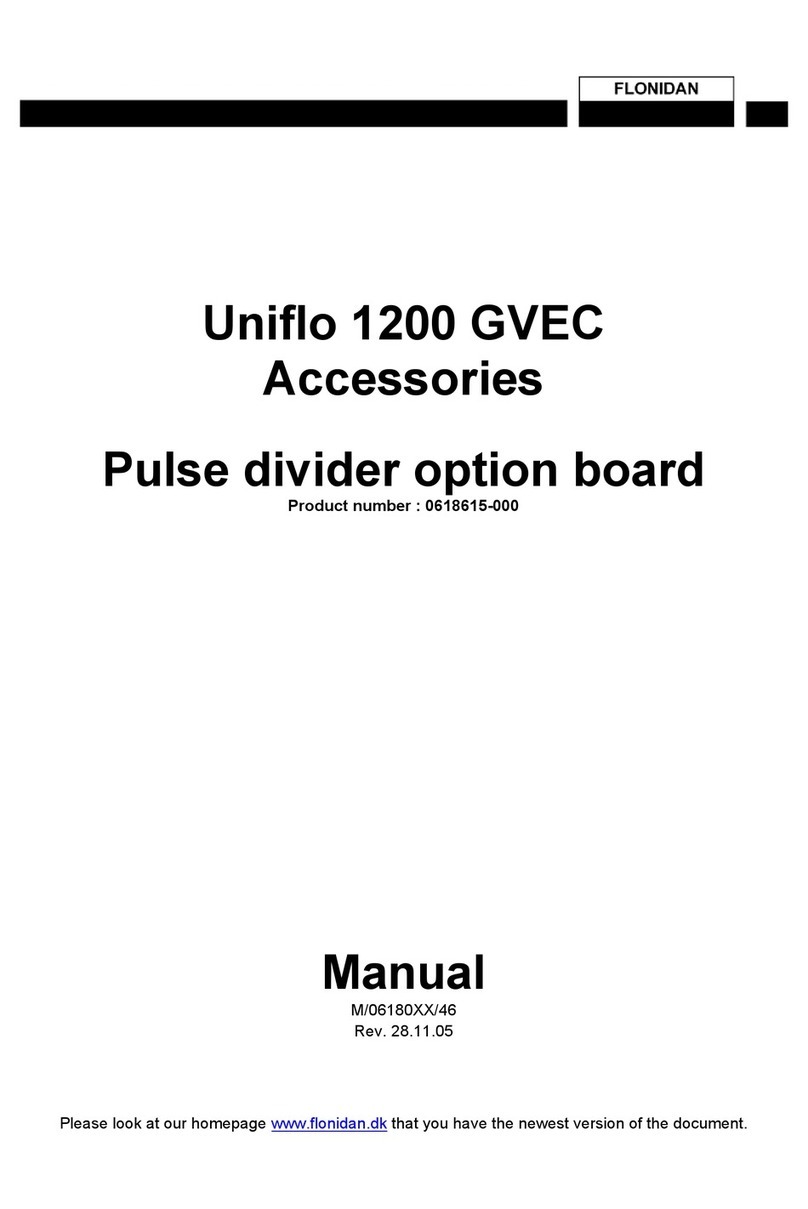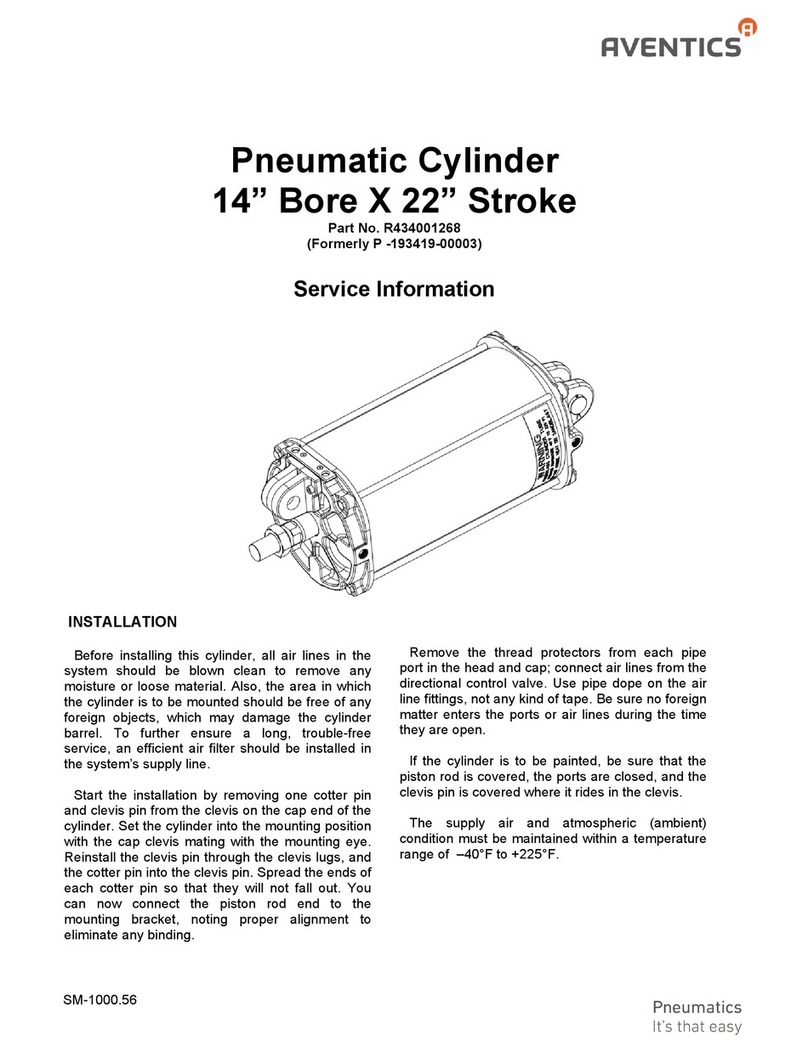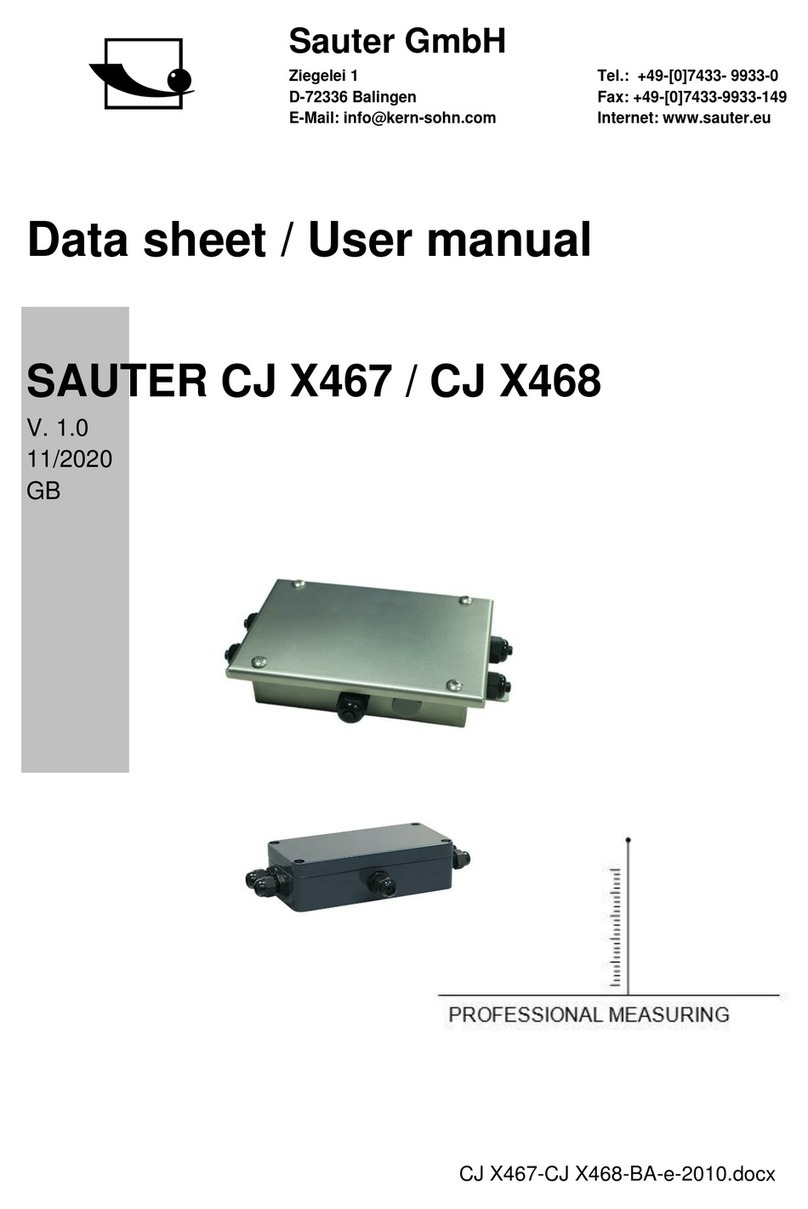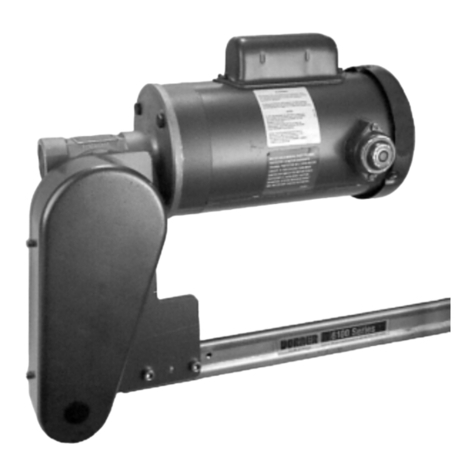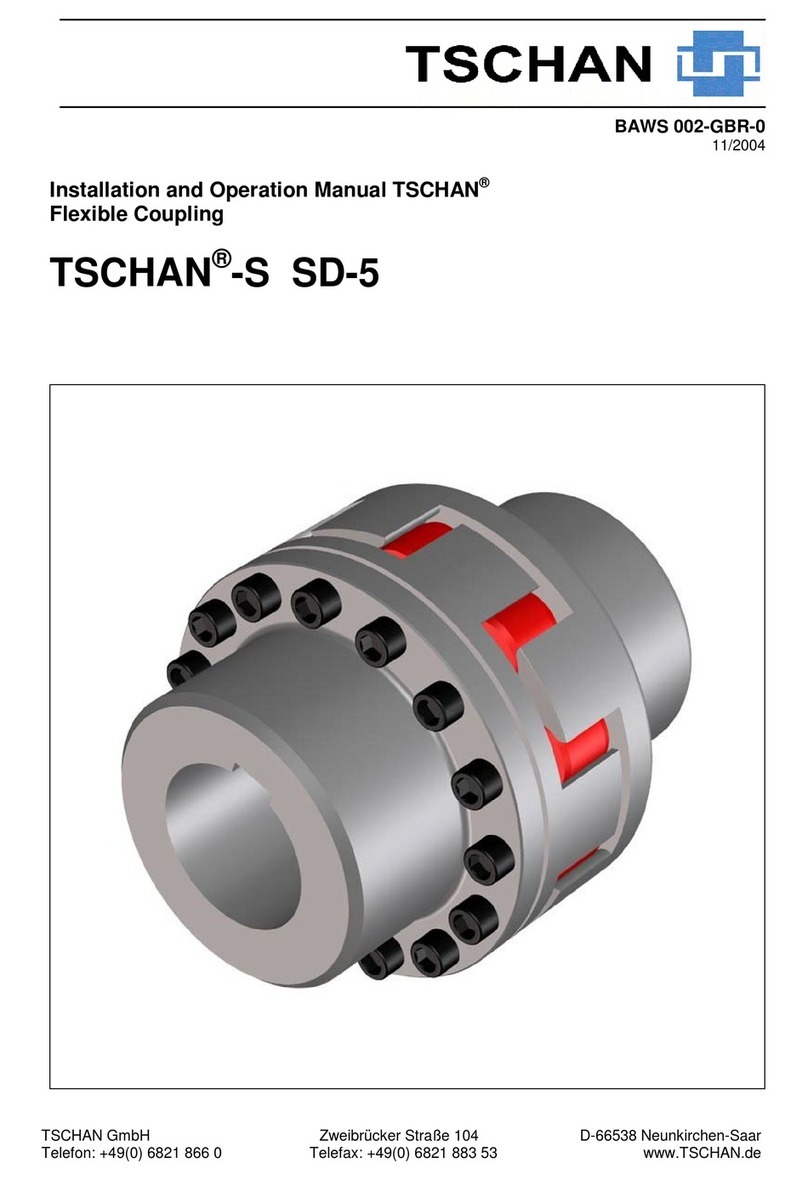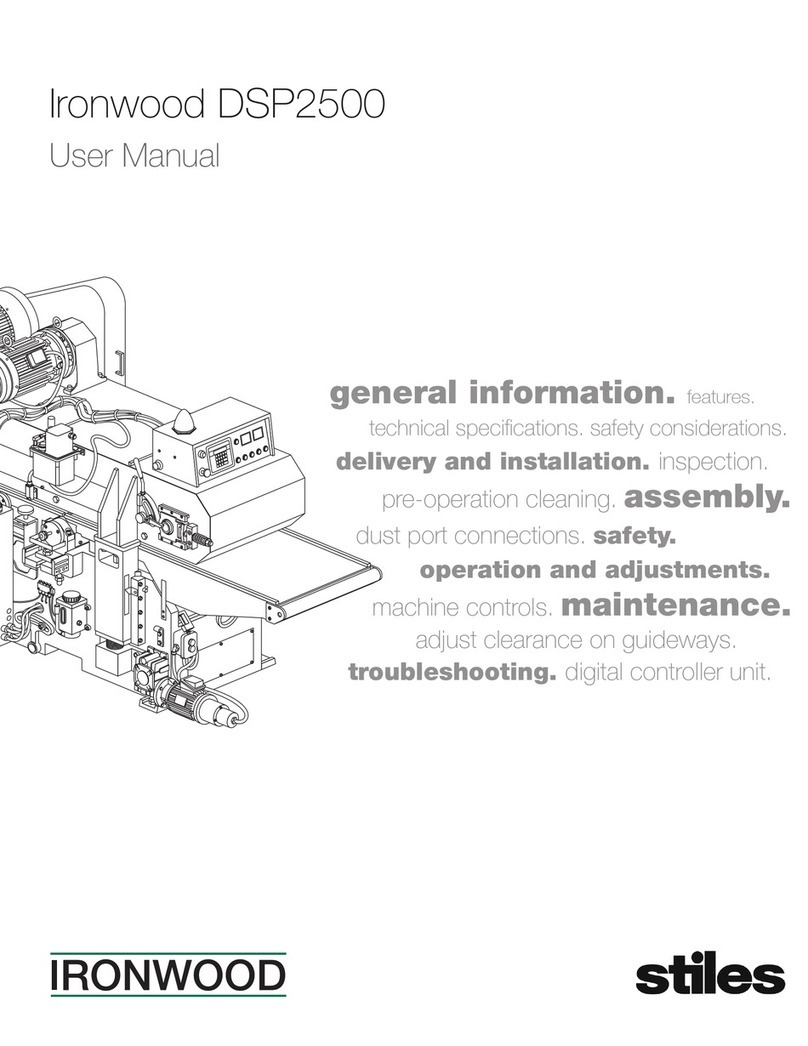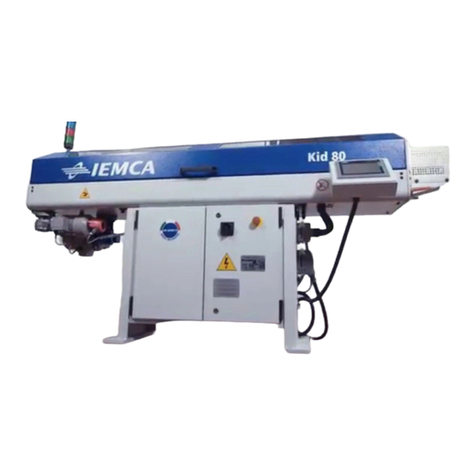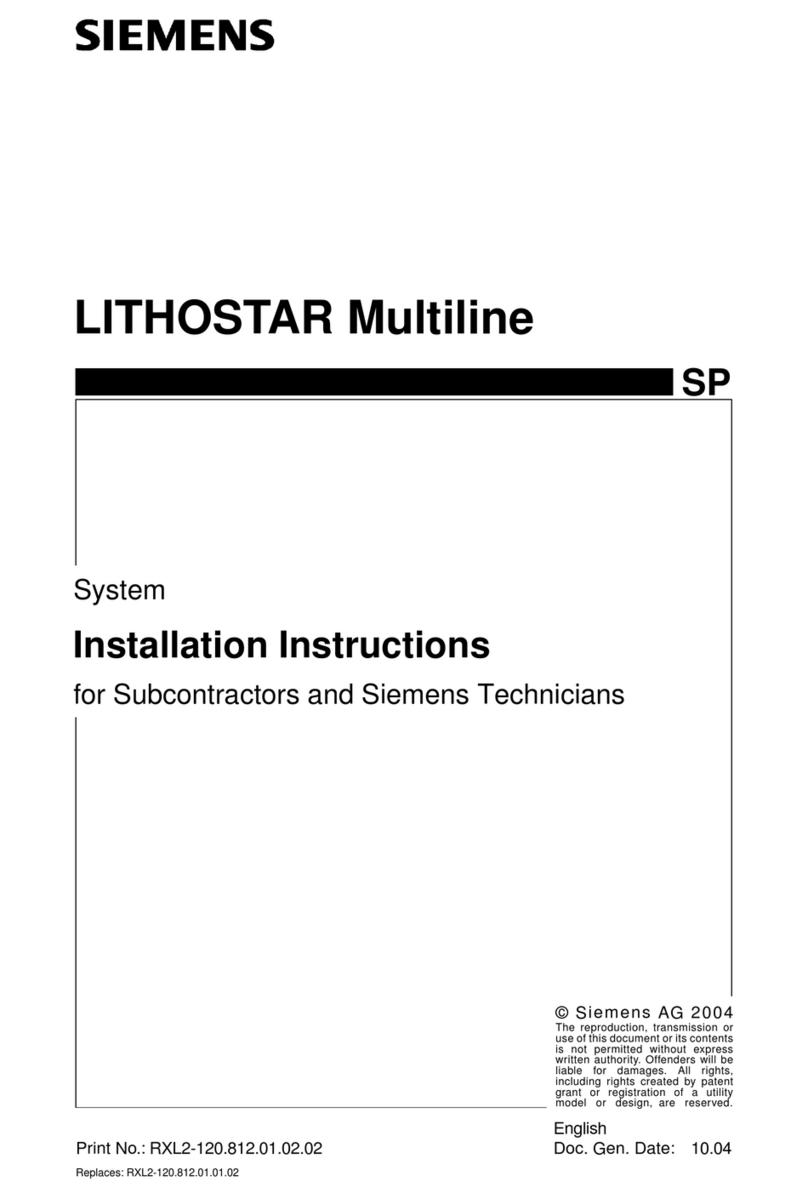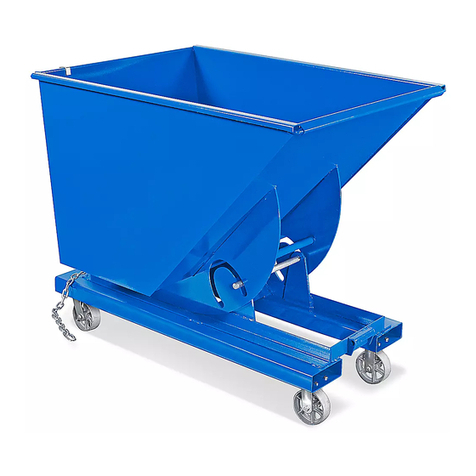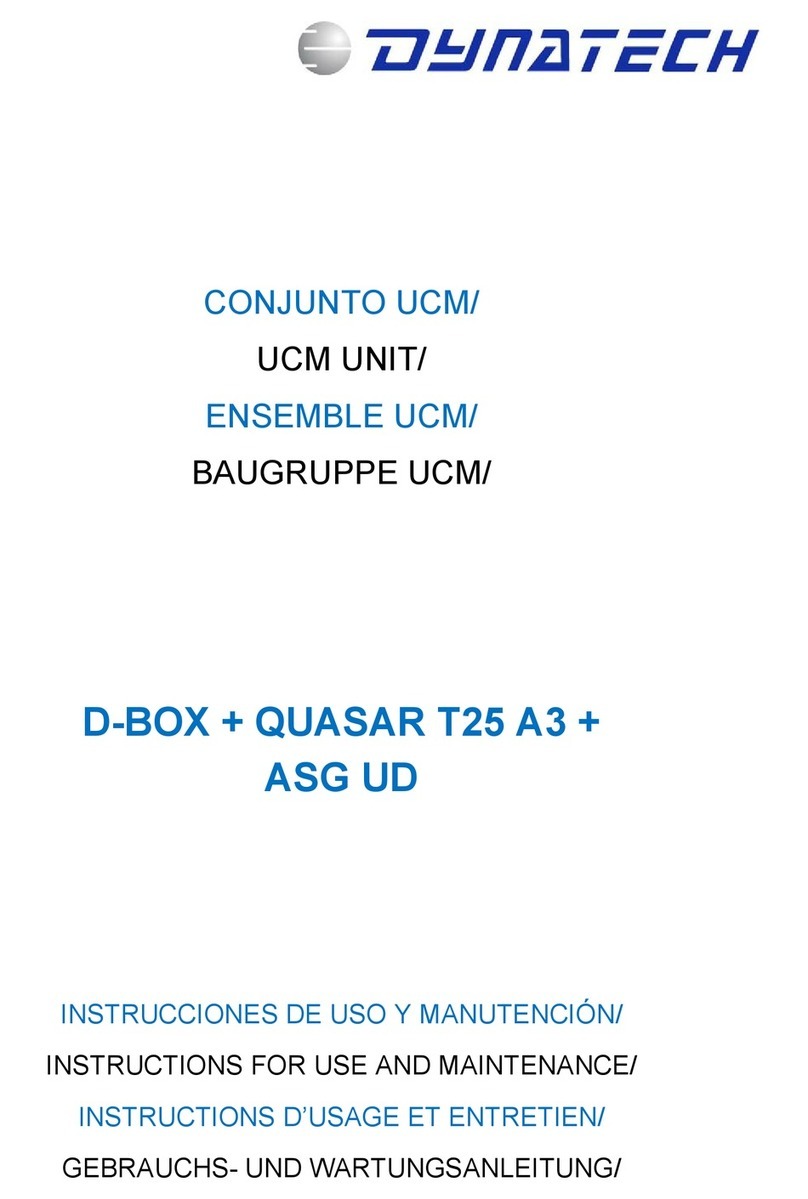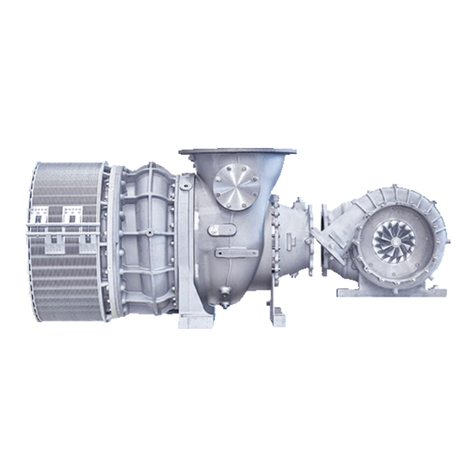KEBCO Combivert R6 User manual

COMBIVERT
GB Instruction Manual Power supply and
regenerative unit
Type R6-S Size 15/19
Mat.No. Rev.
00R6SEB-K000 1C

GB This instruction manual describes the power supply and regenerative unit KEB
COMBIVERT R6-S series. Before working with the unit the user must become
familiar with it. This especially applies to the knowledge and observance of the
following safety and warning indications. The pictographs used in this instruc-
tion manual have following meaning:
GB - 3 … GB - 32 Danger Attention Information
Warning essential
measure
Help
Caution Tip

GB - 3
1. Introduction......................................................................................................................4
1.1 Preface............................................................................................................................................... 4
1.2 Product description.......................................................................................................................... 4
1.3 Speciedapplication........................................................................................................................ 5
1.3.1 Standard operation ............................................................................................................................. 5
1.3.2 Abnormal operation............................................................................................................................. 5
1.4 Unitidentication.............................................................................................................................. 5
2. Safety Instructions ..........................................................................................................6
2.1 General instructions......................................................................................................................... 6
2.2 Transport, Storage and Installation................................................................................................. 6
2.3 Electrical connection........................................................................................................................ 7
2.4 EMC instructions ............................................................................................................................ 10
2.5 EMC conform installation............................................................................................................... 10
3. Technical Data ...............................................................................................................11
3.1 Power data........................................................................................................................................11
3.2 Operating conditions...................................................................................................................... 12
3.3 Accessories..................................................................................................................................... 12
3.4 Options ............................................................................................................................................ 13
3.5 Dimensions and weights................................................................................................................ 13
3.5.1 COMBIVERT R6-S ........................................................................................................................... 13
3.5.2 Commutation throttle......................................................................................................................... 14
3.5.3 HFsub-mountinglter....................................................................................................................... 14
3.5.4 Ferrite rings....................................................................................................................................... 14
4. Installation......................................................................................................................15
4.1 EMC-compatible control cabinet installation............................................................................... 15
4.2 Installation instructions ................................................................................................................. 15
4.3 Connection of the COMBIVERT R6 ............................................................................................... 16
4.3.1 Connection terminals of the power circuit......................................................................................... 16
4.3.2 Connection terminals of the commutation throttle............................................................................. 16
4.4 Connection power circuit R6-S with internal fuses..................................................................... 17
4.4.1 Powersupplyandregenerativeoperationatinvertercurrent≤currentofoneCOMBIVERTR6-S . 17
4.4.2 Powersupplyandregenrativeoperationatinvertercurrents≤currentofoneCOMBIVERTR6-S.. 17
4.4.3 Powersupplyandregenrativeoperationatinvertercurrents≥currentofoneCOMBIVERTR6-S.. 18
4.4.4 Power supply and regenerative operation with contactor circuit....................................................... 19
4.4.5 Regenerative operation with decoupling diodes ............................................................................... 20
4.4.6 Power supply /regenerative operation at parallel operation of COMBIVERT R6-S with recovery
contactor........................................................................................................................................... 21
4.4.7 Regenerative operation at parallel operation of COMBIVERT R6-S with decoupling diodes ........... 22
4.5 Connection of the control board version S.................................................................................. 23
4.5.1 Assignment of the control terminal strip X2A.................................................................................... 23
4.5.2 Assignment of socket X2B................................................................................................................ 23
4.5.3 Wiring example ................................................................................................................................. 24
4.6 Operator........................................................................................................................................... 25
5. Operation of the Unit.....................................................................................................26
5.1 Keyboard ......................................................................................................................................... 26
5.2 Operation with PC und system software COMBIVIS ................................................................... 26
5.3 Switch-on procedure ...................................................................................................................... 26
5.4 Parameter summary ....................................................................................................................... 28
5.5 Password input ............................................................................................................................... 29
5.6 Monitoring- and analysis parameters ........................................................................................... 29
5.7 Special adjustments ....................................................................................................................... 33
A. Appendix ........................................................................................................................36
A.1 Dimensioning of power supply and regenerative units .............................................................. 36
A.2 DC link capacitors of KEB frequency inverters ........................................................................... 37
A.3 Dimensioning of decoupling diodes............................................................................................. 37
Table of Contents

GB - 4
Preface
1. Introduction
1.1 Preface
First we would like to welcome you as a customer of the company Karl E. Brinkmann GmbH
and congratulation to the purchase of this product. You have decided for a product on highest
technical niveau.
The enclosed documents as well as the specied hard- and software are developments of the
Karl E. Brinkmann GmbH. Errors excepted. The Karl E. Brinkmann GmbH has created these
documents, this hard- and software with the best knowledge. We doesn´t accept the guarantee
that the user gets the prot with this specications. The Karl E. Brinkmann GmbH reserves the
right to change specications without prior notice or to instruct third persons. This list is not
exhaustive.
The used pictograms have following signicance:
Danger
Warning
Caution
Attention
observe at
all costs
Information
Help
Tip
1.2 Product description
This instruction manual describes the power supply and regenerative unit KEB COMBIVERT
R6-S. The COMBIVERT R6-S has the following features.
The supply unit
converts a three-phase input voltage into DC voltage.•
supplies KEB frequency inverter individually or via DC interconnection.•
can be parallel connected if higher power supply is required.•
increases the stability of the DC link voltage in the DC interconnection.•
The regenerative unit
feeds back the excess energy from generatoric operation into the supply system.•
reduces the energy demand.•
reduces the heat emission.•
is environmentally friendly and space-saving.•
replaces braking resistor and braking transistor.•
is cost-saving.•
The COMBIVERT R6-S is generally protected against overcurrent, ground fault and tempera-
ture. Appropriate dimensioned DC fuses protects the DC link circuit against short-circuit. The
following accessories are necessary for operation with the COMBIVERT R6-S:
Mains choke•
HF lter (for observance of EMC standard)•

GB - 5
Preface
1.3 Speciedapplication
The COMBIVERT R6-S serves exclusively for the supply of frequency inverters with DC input
and/or feedback of excess energy into the supply system. The operation of other electrical
consumers is prohibited and can lead to malfunctions or to the destruction of the units.
1.3.1 Standard operation
If the DC link voltage increases to a value above the peak value of the mains voltage (negative
power), feedback of the current into the mains occurs automatically. The mains voltage is ana-
log measured. The feedback occurs in a square-wave format, whereby the current ow period
corresponds to the times of a B6 bridge circuit. The feedback is nished if the DC link voltage
decreases the supply peak voltage (positive power).
1.3.2 Abnormal operation
When exceeding the permissible limit values for voltage, current or temperature the current
ow between DC link and mains is blocked during recovery. An appropriate error message is
also displayed during supply. The unit must be disconnected from the supply system or the
load must be switched o in case of overcurrent. This can be done by opening the control re-
lease of the frequency inverter.
At factory setting the modulation is switched o in case of a net phase and/or a synchronisation
line failure and the error message E.nEt is displayed.
Special adjustments from KEB are necessary if the modulation and/or the standard operation
should start again within a dened time in case of return of power supply.
1.4 Unitidentication
1 9 . R 6 . s 3 E - 9 0 0 A
Type A: Heat sink (standard) B: Flat Rear
Design 0: default
reserved 0: default
Voltage 9: 3-ph.; 180…550 V; AC
housing E
Options 0: without 3: Precharging, DC-fuses
1: precharging
Control S: 1B.R6
Series R6
Unit size 15 (13), 19 (16)

6
Safety Instructions
2. Safety Instructions
2.1 General instructions
Electric Shock
COMBIVERT R6 power supply und regenerative units contain dangerous voltages which
can cause death or serious injury.
COMBIVERT R6 can be adjusted by way that energy is refeed into the supply system in
case of power failure at generatoric operation. Therefore a dangerous high tension can be in
the unit after switching off the supply system.
Before working with the unit check the isolation from supply by measurements in the
unit.
Care should be taken to ensure correct and safe operation to minimise risk to personnel and
equipment.
OnlyQualied
Electro-Perso-
nnel
All work from the transport, to installation and start-up as well as maintenance may only be
donebyqualiedpersonnel(IEC364and/orCENELECHD384andIEC-Report664and
notenationalsafetyregulations).Accordingtothismanualqualiedstaffmeansthosewho
are able to recognise and judge the possible dangers based on their technical training and
experience and those with knowledge of the relevant standards and who are familiar with the
eldofpowertransmission.
Observe Stan-
dards
The COMBIVERT R6 must not be started until it is determined that the installation com-
plies with 2006/42/EC (machine directive) as well as the EMC directive (2004/108/EC) (note
EN60204).
TheCOMBIVERTR6meetstherequirementsoftheLow-VoltageDirective2006/95/EC.The
harmonized standard of the series EN 61800-5-1 (VDE 0160) is used.
This is a product of limited availability in accordance with IEC 61800-3. This product may
cause radio interference in residential areas. In this case the operator may need to take
corresponding measures.
2.2 Transport, Storage and Installation
The storage of the COMBIVERT must be done in the original packing. It is to be protected against humidity and
excessive cooling and thermal effect. A long-distance transport must be carried out in the original packing. It is to
besecuredagainstimpactinuence.Themarkingonthenalpackingmustbeobserved!Afterremovingthenal
packing the COMBIVERT must be set down on a stable base.
Protect Against
Accidental
Contact
The COMBIVERT R6 must be protected against invalid loading. Components and covers
must not be bent or moved as this may affect insulation distances. The units contain electro-
static sensitive devices which can be destroyed by inappropriate handling. For that reason
the contact of electronic devices and contacts is to be avoided. The equipment must not be
switched on if it is damaged as it may no longer comply with mandatory standards.
Make sure that during installation there is enough minimum clearance and enough cooling.
Climatic conditions must be observed in accordance with the instruction manual.
Hot Surface
Heat sinks can reach temperatures, which can cause burns when touching. If in case of
structural measures a direct contact cannot be avoided, a warning notice "hot surface" must
be mounted at the machine.

7
Safety Instructions
2.3 Electrical connection
Note Capacitor
Discharge Time
Before any installation and connection work, the system must be switched off and secured.
After clearing the DC link capacitors are still charged with high voltage for a short period of
time. The unit can be worked on again, after it has been switched off for 5 minutes.
Secure
Isolation
The terminals of the control terminal strip are securely isolated in accordance with EN
61800-5-1. With existing or newly wired circuits the person installing the units or machines
must ensure that the EN requirements are met. With frequency inverters that are not isolated
from the supply circuit all control lines must be included in other protective measures (e.g.
double insulation or shielded, earthed and insulated).
Voltage With
Respect To
Ground
Connection of the COMBIVERT R6 is only permissible on symmetrical networks with a maxi-
mumlinevoltage(L1,L2,L3)withrespecttoearth(N/PE)of317V.Anisolatingtransformer
mustbeusedforsupplynetworkswhichexceedthisvalue!Theunitsmaybedamagedif
this is not observed.
Earthed Exter-
nal
Conductor
The COMBIVERT R6 can be connected to power systems with earthed external conductors
(e.g. delta power systems) if the following exceptions apply:
the control system is no longer regarded as “safe isolated circuit”, further protection•
measures are required therefore
with this type of power system, the max. voltage phase / earth must not exceed 550 V•
absolute
external DC fuses at the DC connections are necessary for the 400 V class. Use the•
COMBIVERT R6-S without internal DC fuses.
Only Fixed
Connection
TheCOMBIVERTR6isdesignedforxedconnectiononlyasdischargecurrentsof>3.5
mAmayoccurespeciallywhenusingEMIlters.Thereforeitisnecessarytolayaprotective
conductor with a section of at least 16mm2 (copper) or a second protective conductor in
compliance with EN
61800-5-1. Ground point-to-point with the shortest connection possible
to mains earth (avoid earth loops).
Insulation Mea-
surement
When doing an insulation measurement in accordance with VDE 0100 / Part 620, the po-
wersemiconductoroftheunitandexistingradiointerferenceltersmustbedisconnected
because of the danger of destruction. This is permissible in compliance with the standard,
since all inverters are given a high voltage test in the end control at KEB in accordance with
EN 50178.
Different Earth
Potentials
When using components without isolated inputs/outputs, it is necessary that equipotential
bonding exists between the components to be connected (e.g. through the equalizer). Disre-
gard can cause destruction of the components by the equalizing currents.

8
Safety Instructions
Prevent
Disturbances
A trouble-free and safe operation of the COMBIVERT R6 is only guaranteed when the con-
nection instructions below are strictly followed. Incorrect operation or damage may result
from incorrect installation.
Pay attention to mains voltage.•
•Installpowercablesandcontrolcablesseparately(>15cmseparation).•
•Useshielded/twistedcontrollines.LayshieldatonesidetoCOMBIVERTR6-Sto•
PE!
Only use suitable circuit elements to control the logic and analog inputs, whose contacts•
are rated for extra-low voltages.
Housing of the COMBIVERT R6 must be well earthed. Screens of larger power cable•
must be directly and securely attached to both the inverter PE terminal and the motor
ground terminal (remove paint).
•Groundthecabinetorthesystemearthstarpointwiththeshortestconnectiontomains•
earth (avoid earth loops)
UseexclusivelythelinecommutationthrottlespeciedbyKEB.•
The average value of the supplied DC current may not exceed the maximum DC•
current.
If several frequency inverters are connected to the COMVIBERT R6-S the max. permis-•
sible DC link capacities of all connected frequency inverters must be considered during
supply operation (see technical data).
Automatic Re-
start
The COMBIVERT R6 can be adjusted by such way that the inverter restarts automatically
after an error case (e.g. broken phase line). System design must take this into account, if
appropriate, and additional monitoring or protective features added where necessary.
Not Short-Cir-
cuit Proof
(Supply)
The COMBIVERT R6 is not short-circuit proof at the power supply input
!IftheI2t-protection
is adapted with a gR fuse, a conditional protection at supply input is possible. If necessary
the short-circuit protection at DC output is ensured by internal aR fuses.
Conditionally
Short-Circuit
Proof
(Feedback)
The COMBIVERT R6 is conditionally short-circuit proof (EN 61800-5-1 / VDE 0160). After
resetting the internal protection devices, the function as directed is guaranteed.
Exception:
•Ifanearth-leakagefaultorshort-circuitoftenoccursattheoutput,thiscanleadtoa•
defect in the unit.
Cyclic Activati-
on And Deacti-
vation
With applications requiring the COMBIVERT R6 to be switched on and off cyclically, maintain
an off-time of at least 5 min. If you require shorter cycle times please contact KEB.

9
Safety Instructions
RCD (Residual
Current Ope-
rated Circuit-
Breaker)
If personnel protection of the system is required, the COMBIVERT R6-S must be protected
according to EN 61800-5-1:
•3-phaseinverters(withB6bridge-connectedrectier)byRCMA’swithseparation(used•
privileged)orRCD’stypeB(all-currentsensitiveFI’s)
The tripping current should be 300mA or more, in order to avoid a premature triggering by
discharge currents (about 200mA. Dependent on the load, the length of the motor cable
and the use of a radio interference lter, substantially higher leakage current can occur.
The connection instructions from the manufacturer and the valid local reqirements must be
observed.
Dependent on the available mains form (TN, IT, TT) further protective measures are neces-
sary in accordance with VDE Part 410 4 (Part 4; Chapter 41).
For example, with TN-mains this protection is made with overcurrent protective devices,
with IT-mains it is insulation monitoring with a pulse-code measuring method. A protective
separation can be used with all mains forms as long as the required power and cable lengths
permit this.
The person setting up the unit must present proof of compatibility before installing the inver-
ter!
Circuit diagram of low voltage distribution (principle of the protective elements)
Mains
to further
sub-divisions
Outlet 1
Outlet 2
Outlet 3
Level1
Level2
type
A
type
A
RCD
type A
sel. T RCMA/
RCD
type B
Isolator
according to
EN 60947-2
To further consumers that do not pre-
vent the tripping of the FI.
To the consumers not
compatible with FI.

10
EMC instructions
2.4 EMC instructions
COMBIVERT R6-S represent electrical equipment designed for use in industrial and commercial units. In accor-
dance with the EMC directive 89/336/EEC, it is not obligatory to mark these devices as they represent compon-
ents to be further processed by the respective machine and unit manufacturer and are not operable independently
according to the EMC directive. The person installing / operating the machine / unit is obliged to proove the
protective measures demanded by the EMC directive are complied with. The prescribed ratings can usually be
compliedwithwhenusingtheradiointerferencevoltageltersspeciedbyKEB,andwhenobservingthefollowing
measures and installation guidelines.
2.5 EMC conform installation
TheCOMBIVERTR6isdesignedtobeusedinthesecondenvironmentasdenedinEN61800-3(unitwithits
ownsupplytransformer).Takeadditionalmeasureswhenusingitintherstenvironment(residentialandcom-
mercialareaconnectedtopubliclow-voltagemains)!
Install the control cabinet or system in an appropriate and correctly way (see chapter „control cabinet instal-•
lation“)
To avoid coupled-in noise, separate supply lines, motor lines, control and data lines (low-voltage level < 48V)•
and leave a space of at least 15 cm between them when installing.
In order to maintain low-resistance high frequency connections, earthing and shielding, as well as other metal-•
lic connections (e.g. mounting plate, installed units) must be in metal-to-metal contact with the mounting plate,
over as large an area as possible. Use earthing and equipotential lines with a section as large as possible
(min. 16mm2) or use thick earthing strips.
Only use shielded cable with copper or tin-plated braid, since steel braid is not suitable for high frequency ran-•
ges. The screen must always be installed on the compensating rail and fastened with clips or guided through
thewallofthehousing.Donotelongatethescreenend(pigtails)withindividualconductors!
Ifexternal interferencesuppressionlters areused, thenthesemust beinstalled ascloseas possibleto•
(<30cm from) the interference source and in metal-to-metal contact with the mouting plate, over as large an
area as possible.
Always equip inductive control elements (contactors, relays etc.) with suppressors such as varistors, RC-ele-•
ments or damping diodes.
Allconnectionsmustbekeptasshortaspossibleandascloseaspossibletotheearth,asfreeoatinglines•
work as active and passive aerials.
Keep connection cables straight (do not bundle). Install a non-assigned wire at one sides to the protective•
earth conductor.
Theowandreturncircuitmustbetwistedwhenthelinesarenotshielded,inordertodampencommon-mode•
noise.
The cable for phase synchronisation between mains choke and COMBIVERT R6-S may not exceed a line•
length of 1 m.
Further informations are found in the internet, see „www.keb.de“.•

GB - 11
Technical Data
3. Technical Data
3.1 Power data
Unit size *) 15 (13) 19 (16)
Housing size E
Phases 3
Rated voltage *) [V] 400 (230)
Mains voltage [V] 180…550 ±0 %
Mains frequency [Hz] 50 / 60 ±2
Regenerative operation
Output rated power *) [kVA] 18 (10,5) 45 (26)
Rated active power *) [kW] 17 (10) 42 (23)
Max. power output *) [kVA] 27 (15,5) 67,5 (39)
Max. active power *) [kW] 25,5 (15) 63 (34,5)
Regenerative rated current [A] 26 65
Regenerative DC current [ADC] 32 80
Overloadcurrent(E.OL)60s 1) [A] 39 97,5
Max. regenerative DC current 60 s [ADC] 48 120
Power supply operation
Output rated power *) [kVA] 18 (10,5) 48,5 (28)
Rated active power *) [kW] 16 (10) 44,5 (25,5)
Max. input power *) [kVA] 27 (15,5) 72,5 (42)
Max. active power *) [kW] 24 (14,5) 67 (38)
Rated supply current 2) [A] 26 70
DC supply current [ADC] 32 87 3)
Overloadcurrent(E.OL)60s [A] 39 105
Max. DC supply current 60 s [ADC] 48 130
Overloaddisconnection(E.OL) [%] 160 160
DC output voltage *) [VDC] 425…780 (250…370)
Max. permissible DC link capacity 4) *) [µF] 5000 (21500) 5000 (21500)
Max. permissible mains fuse type gR [A] 40 100
I2t Integral of the limiting load of the semiconduc-
tor
[A2s] 1200 4500
Perm. aR fuse Siemens Sitor (no delta power system) 3NC2240 3NC2200
Supply line cross section (min) [mm²] 0,5 1,5
Supply line cross section (max) [mm²] 10 (AWG 8) 25 (AWG 4)
DC line cross section (min) [mm²] 0,5 1,5
DC line cross section (max) [mm²] 10 (AWG 8) 25 (AWG 4)
Short-circuit factor at the connection point (Smains/SN) <350
Power loss at nominal operating [W] 200 470
Max. heat sink temperature [°C] 70 88
*) Bracket values obtain for operation at 230V power supply. The unit is automatically adjusted by the software when switching on.
1) The overcurrent is specied for 1 minute. The overload cycle is 300 seconds. This corresponds to duty class 2 EN 2‑60146‑1.
2) The current data are based on a fundamental frequency component of g=0,95. The fundamental frequency component or the effective value of
the input current is dependent on load and line supply conditions. At uncontrolled B6 converters the phase angle cosφ1 can be set to one, so the
value of the fundamental frequency components is equal to the value of the power factor.
3) If the DC‑infeed current > 85 A DC use two by two of the DC terminals (++ and ‑‑) to meet the requirements of the UL standard. The connection
cables are parallel connected.
4) Please contact KEB for higher values.
Voltage stabilization must be activated at the inverter if a harmonic lter is used.
The units are not short circuit proof without corresponding dimensioned fuses
Exceeding of the max. rechargeable DC link capacity can lead to a defect.
A load removal in the DC link circle may be done only after the message „ready“.
Site altitude maximal 2000 m. With site altitudes over 1000 m a derating of 1 % per 100 m must be taken into con-
sideration.

GB - 12
Technical Data
3.2 Operating conditions
Standard Standard/
class
Instructions
Denitionaccordingto EN 61800-2 Inverter-product standard: ratedspecications
EN 61800-5-1 Inverter-product standard: general safety
Site altitude
max. 2000 m above sea level
With site altitudes over 1000 m a derating of 1 % per
100 m must be taken into consideration.
Ambient conditions during operation
Climate Temperature EN 60721-3-3 3K3
extended to -10…45 °C
(with temperature over 45°C to max. 55°C a deration of
5 % per 1 K must be taken into consideration)
Humidity 3K3 5…85 % (without condensation)
Mechanical Vibration
Track EN 50155 max. amplitude of a vibration 1 mm (5…13 Hz)
max. acceleration amplitude 7 m/s² (13…200 Hz) sine
Germ. Lloyd Part 7-3
EN 60721-3-3 3M1
Contamination Gas 3C2
Solids 3S2
Ambient conditions during transport
Climate Temperature EN 60721-3-2 2K3
Humidity 2K3 (without condensation)
Mechanical Vibration
Track EN 50155 max. amplitude of a vibration 3,5 mm (2…9 Hz)
max. acceleration amplitude 15 m/s² (9…200 Hz) sine
Germ. Lloyd Part 7-3
EN 60721-3-2 2M1
Surge EN 60721-3-2 2M1 max. 100 m/s²; 11 ms
Contamination Gas 2C2
Solids 2S2
Ambient conditions for the storage
Climate Temperature EN 60721-3-1 1K4
Humidity 1K3 (without condensation)
Mechanical Vibration
Track EN 50155 max. amplitude of a vibration 1 mm (5…13 Hz)
max. acceleration amplitude 7 m/s² (13…200 Hz) sine
Germ. Lloyd Part 7-3
EN 60721-3-1 1M1
Surge EN 60721-3-1 1M1 max. 100 m/s²; 11 ms
Contamination Gas 1C2
Solids 1S2
Type of protection EN 60529 IP20
Environment IEC 664-1 Pollution degree 2
Denitionaccordingto EN 61800-3 Inverter-product standard: EMC
EMC emitted interference (see instruction manual)
Cable-based interferences EN 55011 C3 ≙Limit A (B optional)
Radiated interferences EN55011 C3 ≙Limit A
EMC interference immunity
ESD EN 61000-4-2 8 kV AD (air discharge) and CD (contact discharge)
Burst - control lines + bus EN61000-4-4 2 kV
Burst - mains supply EN61000-4-4 4 kV
Surge - mains supply EN61000-4-5 1 / 2 kV Phase-phase / phase-ground
EMF EN 61000-4-3 10 V/m
Voltage variation /
voltage drop EN 61000-2-1 +10 %, -15 %; 90 %
Voltage unsymmetries /
Frequency changes EN 61000-2-4 3 %; 2 %

GB - 13
Technical Data
3.3 Accessories
Unit size 15 (13) 19 (16)
Rated voltage 400 V
Commutation throttle 15Z1B05-1000 15Z1B05-1001 19Z1B05-1000
max. short-term overload
(regenerative) 110 % 160 % 160 %
max. short-term overload
(motoring) 140 % 160 % 160 %
Patch cable (length 1 m) 00F50C3-4010
3.4 Options
Unit size 15 (13) 19 (16)
Mains lter 15E4T60-1001
in accordance with EN 55011 class A
19R6T60-1001
in accordance with EN 55011 class A
LimitclassBonconsultationwithKEB
Ferrite rings see 3.5.4
Harmonic lter
15Z1C04-1002 19Z1C04-1002
Please contact KEB for further sizes and data to the THD value at generatoric
operation
DC fuses 690 V / 50A
(Part number 009025H-3459)
690 V / 125A
(Part number 009025H-3559)
Operators Digital operator, Interface operator
Bus operators CAN,ProBus,InterBus,Ethercat,Ehternet,Sercos,ModBus,Devicenet,
HSP5
3.5 Dimensions and weights
3.5.1 COMBIVERT R6-S
H
C
B
A
Ø F
C1
Housing A B C C1 F H Weight
E 130 290 208 14 7 275 5.6 kg
C1 with operator

GB - 14
Technical Data
3.5.2 Commutation throttle
ØF
B
H G
C A
Part number A B C F G H Weight
15.Z1.B05-1000 75 240 180 5,5 54 166 5.6 kg
19.Z1.B05-1000 115 289,5 243 7 85 225 13.7 kg
3.5.3 HFsub-mountinglter
CA
G
BH
ØF
Part number A B C F G H Weight
15.E4.T60-1001 50 352 132 7 100 335 2kg
19.R6.T60-1001 65 422 198 7 150 397 6 kg
3.5.4 Ferrite rings
Ferrite rings are used for the reduction of the cable-based and radiated interferences. For a high
damping, the ferrite rings are attached as close as possible to the interference source, i.e. at the DC
and at the motor output terminals of the frequency inverter. The conductors must passed through the
ferrite core for the use as current-compensated choke. PE must be passed outside. Further informa-
tion can be taken from the provided documentation. Which ferrite ring shall be used is dependent on
the used cable cross-section.
Part number Nominal size in mm Inside diameter in mm
0090396-2621 R 42/26/18 24,9
0090390-5241 R 56/32/18 29,5
0090395-3820 R 63/38/25 36,0
0090395-5222 R 87/54/30 54,5
0090395-5520 R 102/66/15 64,5

GB - 15
Installation
4. Installation
4.1 EMC-compatible control cabinet installation
1 Main fuse
150 mm
30 mm
150 mm
1
2
3/6
8
7
10b 9
10c
10a
11
11 a
12
4 + 5
2 Main contactor
3Harmonic lter
4 COMBIVERT R6
5HF sub-mounting lter
6 Commutation throttle
7 Frequency inverter
8External DC fuses (if necessary)
9Motor lines
10a Protective Earth (PE) on the mounting
plate power circuit
10b Protective Earth (PE) on the mounting
plate control circuit
10c Equipotential bonding with the housing
earth
11 Mains connection power circuit
11a Mains connection control circuit
12 Control lines
Large area contact at the mounting plate
Control circuit Power circuit Direction of the cooling
ns
4.2 Installation Instructions
•Stationarily install and earth COMBIVERT.
•The device must not be permeated by mist or water.
• Allow for sucient heat dissipation if installed in a dust-proof housing.
•Install the COMBIVERT in an appropriate housing in accordance with the local regu-
lations when operating it in explosion-endangered spaces.
•Protect COMBIVERT against conductive and aggressive gases and liquids.
•The lines of the R6-S commutation throttle must be limiting to 50 cm.
•The frequency inverters must be placed in the immediate environment of the R6-S.

GB - 16
Connection Terminals
4.3 Connection of the COMBIVERT R6
4.3.1 Connection terminals of the power circuit
Pay attention to the input voltage, since 230 V and 400 V class are possible !
Housing Size E
Name
Tightening torque [Nm]
- - ++
L12++ L32L22
- -
Permissible line cross section [mm²] Size
15
2
⋮
4
Size
19
2
⋮
4
Function Size
15
0,5
⋮
10
Size
19
1,5
⋮
25
L12
L22
L32
3-phase supply input of the commu-
tation throttle
++
– –
DC voltage input with inrush current
limiting
PE,
Connection for shielding/grounding
occurs via provided copper bar by
clamping yoke or ring thimble. It must
be mounted with four screws at the
heat sink. The strain relief and the
shielding must be done by the cus-
tomer.
– 1,3
4.3.2 Connection terminals of the commutation throttle
15/19.Z1.B05-1000
Name
Tightening torque [Nm]
L1.1 L1.2 L2.1 L2.2 L3.1 L3.2
X2B
PE
PE
Permissible line cross section [mm²] Size
15
2
⋮
4
Size
19
6
⋮
8
Function Size
15
1,5
⋮
16
Size
19
2,5
⋮
35
L1.1
L2.1
L3.1
3-phase mains connection
L1.2
L2.2
L3.2 Output to COMBIVERT R6-S
X2B see below – –
PE Connection for shielding /earthing – 6
X2B RJ45-socket for phase synchronization and tempe-
rature sensor
No. Name Function
1 t1 Connection for temperature sensor
2 t2
3 U13_syn Synchronization phase 1 / 3
4 – reserved
5 U21_syn Synchronization phase 2 / 1
6 – reserved
7 U32_syn Synchronization phase 3 / 2
8 – reserved

GB - 17
Connection Power Unit
4.4 Connection power circuit R6-S with internal fuses
4.4.1 Powersupplyandregenerativeoperationatinvertercurrent≤currentofone
COMBIVERT R6-S
L1’
L2’L2
L3’
L1
L3
L1.2
X2B
L2.2L2.1
L3.2
L1.1
L3.1
L2
L1
L3
++
++
X2B
- -L22
- -
L12
L32
1 2 4 5
8
63 10
++/+PA
- - / -
PE
W
V
U
PE
4.4.2 Powersupplyandregenrativeoperationatinvertercurrents≤currentofone
COMBIVERT R6-S
L1’
L2’L2
L3’
L1
L3
L1.2
X2B
L2.2L2.1
L3.2
L1.1
L3.1
L2
L1
L3
++
++
X2B
- -L22
- -
L12
L32
2 3 4 5
98
6
10
1 7
10
++/
+PA
- -/
-
++/
+PA
- -/
-
PE
UVW
PE
UVW
PE
1 Mains fuse type gR 5 COMBIVERT R6-S with inter-
nal fuses
9 Frequency inverter
2 Mains contactor 6 DC fuses type aR/gR 1) 10 Motor
3HFlter 7 DC fuses type aR/gR
4 Commutation choke / harmonic
lter
8 Frequency inverter with IN(9)≤
IN(8)
1) The cable cross‑section may not be smaller than 10 mm². It must be dimensioned for the DC rated current of the load. Otherwise there are fuses
in the DC link circle (6) necessary The indicated maximum protection for the connected frequency inverters must be observed !

GB - 18
Connection Power Unit
4.4.3 Powersupplyandregenrativeoperationatinvertercurrents≥currentofone
COMBIVERT R6-S
--> (parallel operation)
L1’
L2’L2
L3’
L1
L3
X2B
L2
L1
L3
++
++
X2B
- -L22
- -
L12
L32
1 2
6 8
7
L1’
L2’L2
L3’
L1
L3
L1.2
X2B
L2.2L2.1
L3.2
L1.1
L3.1
L1.2
L2.2L2.1
L3.2
L1.1
L3.1
++
++
X2B
- -L22
- -
L12
L32
3 4
10
11
PE
W
V
U
9
11
PE
W
V
U
A ≥ 25mm²
PE
++
+PA
- -
-
++
+PA
- -
-
5a
5b
1 Mains contactor 5a COMBIVERT R6-S master with
internal fuses
9 DC fuses type aR/gR
2 Mains fuse type gR 5b COMBIVERT R6-S slave with
internal fuses
9 Frequency inverter with IN(9) < IN(5)
3HFlter 6 External terminal 1) 10 Frequency inverter with IN(10)>IN(5) 1)
4 Commutation choke /
harmoniclter3)
7 DC fuses type aR/gR 2) 11 Motor
1) If the inverter current > current of the COMBIVERT R5‑S it must be wired at an external terminal (6).
2) The cable cross‑section may not be smaller than 10 mm². It must be dimensioned for the DC rated current of the load. Otherwise there are fuses
in the DC link circle (7) necessary The indicated maximum protection for the connected frequency inverters must be observed !
3) In case of parallel connection of R6‑S the total power can be smaller up to 15 % caused by production tolerances of the commutation choke. The
impedance voltages uk of the commutation chokes must be the same in case of parallel connection of R6‑S with different sizes.

GB - 19
Connection Power Unit
4.4.4 Power supply and regenerative operation with contactor circuit
Regenerativeinvertercurrents≤currentofoneR6-S
L1’
L2’L2
L3’
L1
L3
L1.2
X2B
L2.2L2.1
L3.2
L1.1
L3.1
L2
L1
PE
L3
++
++
X2B
- -L22
- -
L12
L32
7
1
4
9
PE
UVW
PE
PE
PE
UVW
L1’
L2’L2
L3’
L1
L3
365
5
L2L3 L1
8
1211
10
13
13
PE
2
++/
+PA
- -/
-
++/
+PA
- -/
-
1 Mains contactor 6 Mains choke 1) 3) 11 DC inverter
2 Regenerative contactor 2) 7 Commutation choke 1) 3) 12 Inverter with DC output
3 Mains fuse 8 COMBIVERT R6-S 13 Motor
4 Seminconductor fuses gR 9 DC fuses type aR/gR
5HFlter 10 DC fuses type aR/gR 4)
1) Current sharing between R6‑S and frequency inverter must be observed during supply operation. The current sharing is depending on the uk‑
value and the rated current of the mains chokes /commutation chokes (see formula below). A mains choke with uk=4 % is mandatory required
for reduction of circulating currents.
2) The regenerative contactor may only be connected if the precharging in the DC link circle of the inverter is completed. If the precharging of R6‑S
and frequency inverter is in the same DC branch, regenerative contactor are eventually not necessary (depending on the charging resistors
and the DC link capacity).
3) Parallel connection of the frequency inverter and R6‑S causes a circulating current in regenerative operation. It is depending on the inductance
of the mains‑/ commutation chokes. The entire regenerative power is 75... 90 % of the R6‑S regenerative power.
4) The cable cross‑section may not be smaller than 10 mm². It must be dimensioned for the DC rated current of the load. Otherwise there are fuses
in the DC link circle (10) necessary The indicated maximum protection for the connected frequency inverters must be observed !
Formula for current sharing
Xchoke
ukchoke Xchoke FI Lchoke FI
=ω•Lchoke ≈–––––– IR6 = –––––––––––––––––– •Itotal = –––––––––––– •Itotal
Inchoke (Xchoke FI + Xchoke R6)Lchoke FI +Lchoke R6

GB - 20
Connection Power Unit
4.4.5 Regenerative operation with decoupling diodes
Regenerativeinvertercurrents≤currentofoneR6-S
L1’
L2’L2
L3’
L1
L3
L1.2
X2B
L2.2L2.1
L3.2
L1.1
L3.1
L2
L1
PE
L3
++
++
X2B
- -L22
- -
L12
L32
2
6
1
1a
4
4
9
PE
UVW
PE
UVW
L1’
L2’L2
L3’
L1
L3
3
5
L2L3 L1
7
8
1211
10
13
13
PEPE
PE
++/
+PA
- -/
-
++/
+PA
- -/
-
1 Mains contactor 5 Mains choke 1) 4) 10 DC fuses type aR/gR 3)
1
A
Regenerative contactor 2) 6 Commutation choke 4) 11 DC inverter
2 Mains fuse 7 COMBIVERT R6-S 12 Inverter with DC output
3 Mains fuse type gR 8 Decoupling diodes 13 Motor
4HFlter 9 DC fuses type aR/gR
1) A mains choke with uk=4 % is mandatory required for reduction of circulating currents.
2) The regenerative contactor may only be connected if the precharging in the DC link circle of the inverter is completed. If the precharging of R6‑S
and frequency inverter is in the same DC branch, regenerative contactor are eventually not necessary (depending on the charging resistors
and the DC link capacity).
3) The cable cross‑section may not be smaller than 10 mm². It must be dimensioned for the DC rated current of the load. Otherwise there are fuses
in the DC link circle (10) necessary The indicated maximum protection for the connected frequency inverters must be observed !
4) Parallel connection of the frequency inverter and R6‑S causes a circulating current in regenerative operation. It is depending on the inductance
of the mains‑/ commutation chokes. The entire regenerative power is 75... 90 % of the R6‑S regenerative power.
Other manuals for Combivert R6
4
This manual suits for next models
1
Table of contents
Other KEBCO Industrial Equipment manuals
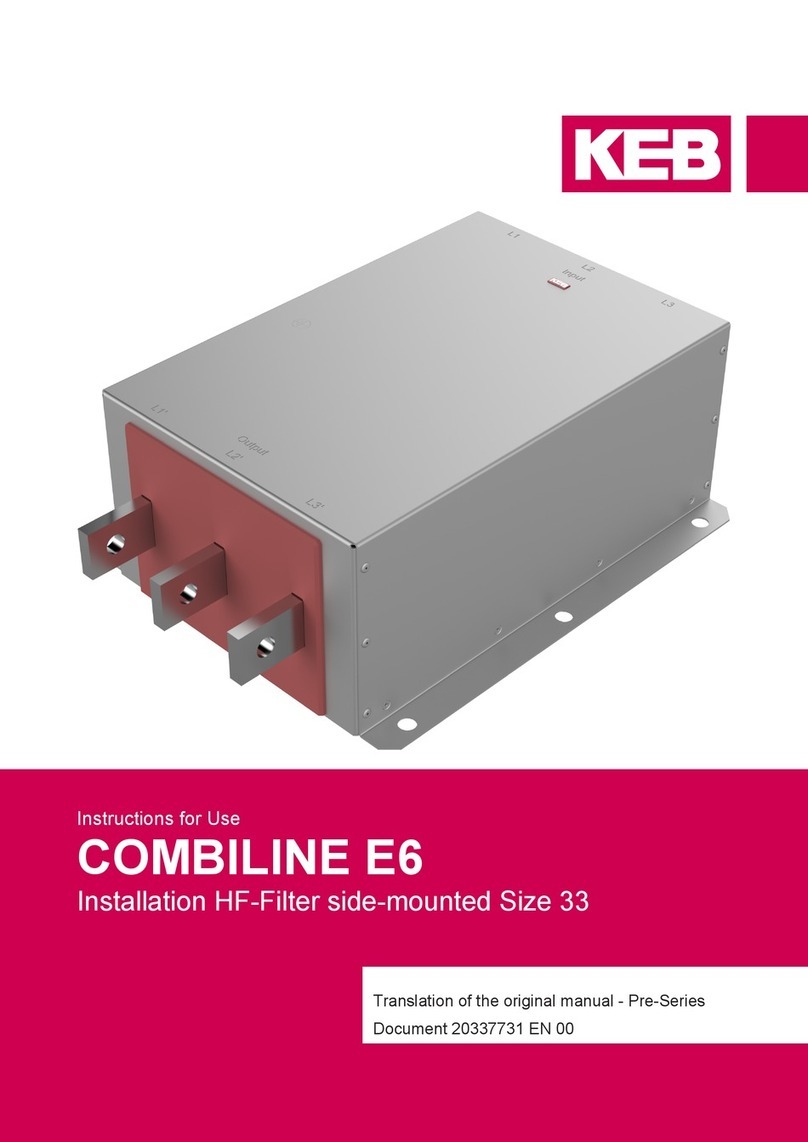
KEBCO
KEBCO COMBILINE E6 Series User manual
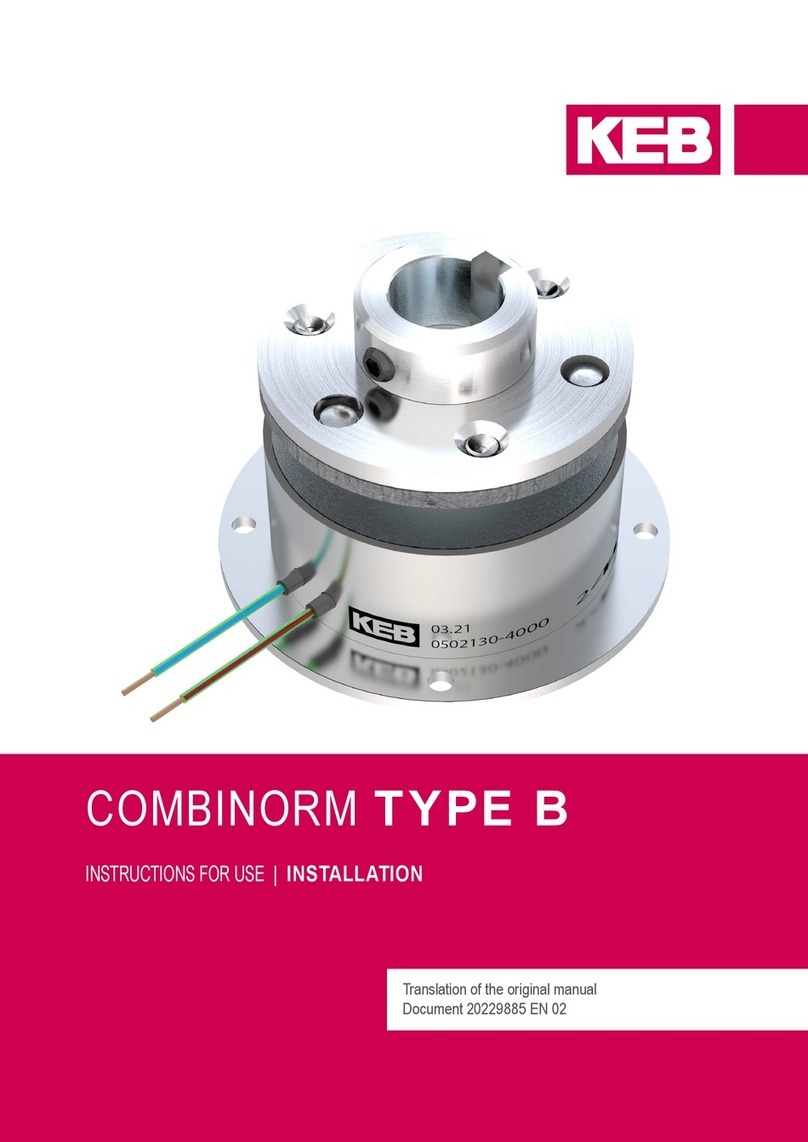
KEBCO
KEBCO COMBINORM B User manual
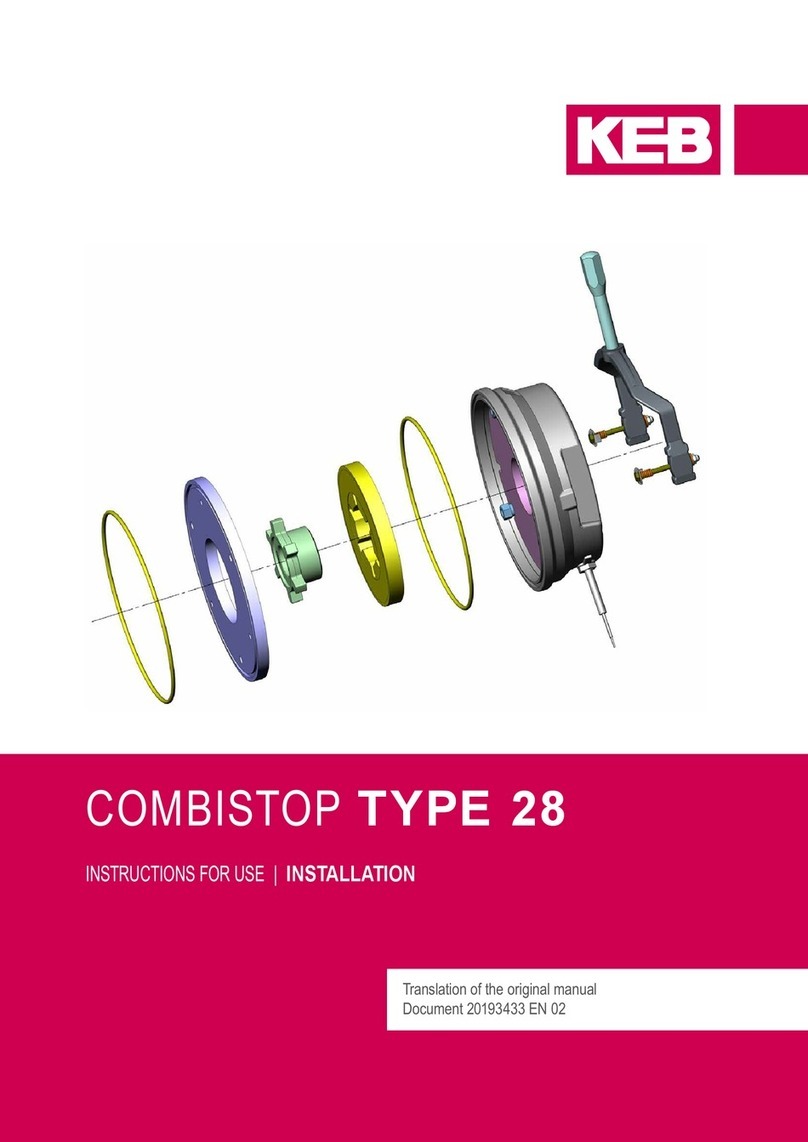
KEBCO
KEBCO COMBISTOP 28 User manual
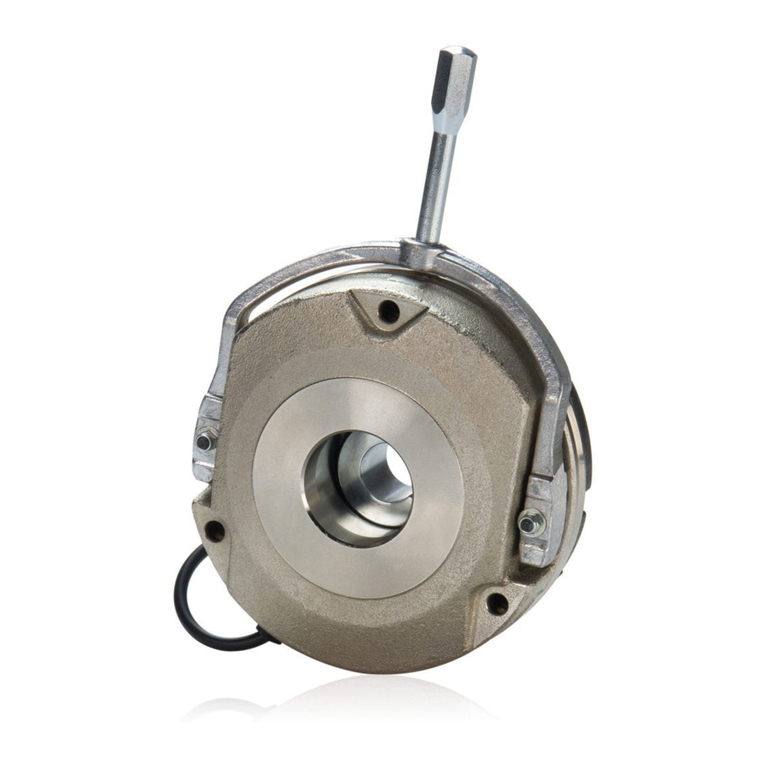
KEBCO
KEBCO COMBISTOP User manual
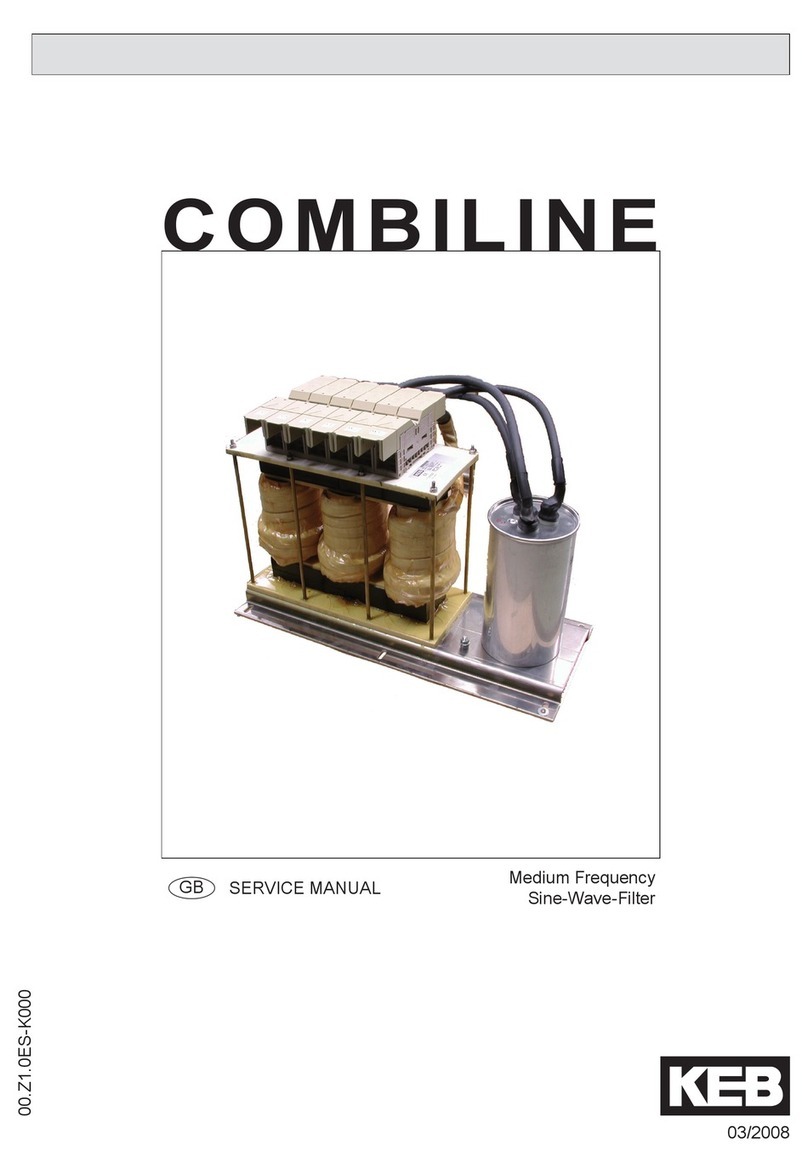
KEBCO
KEBCO COMBILINE User manual
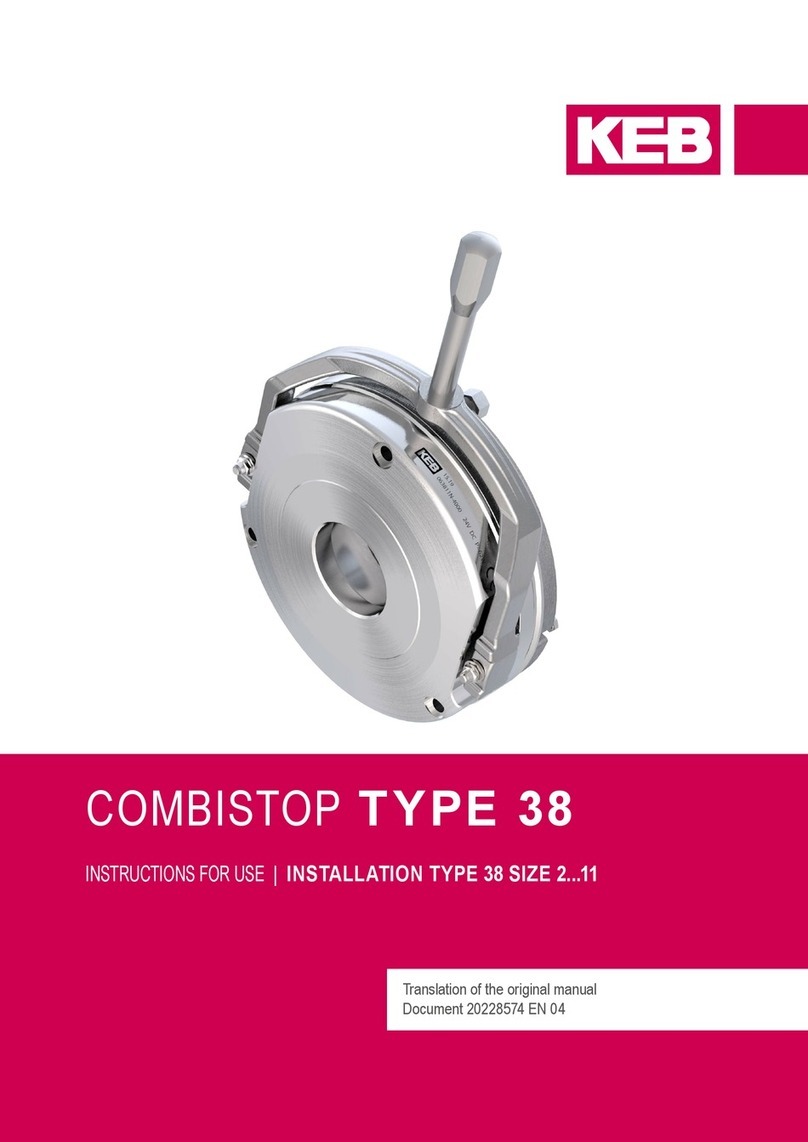
KEBCO
KEBCO COMBISTOP 38 User manual

KEBCO
KEBCO COMBICOM User manual
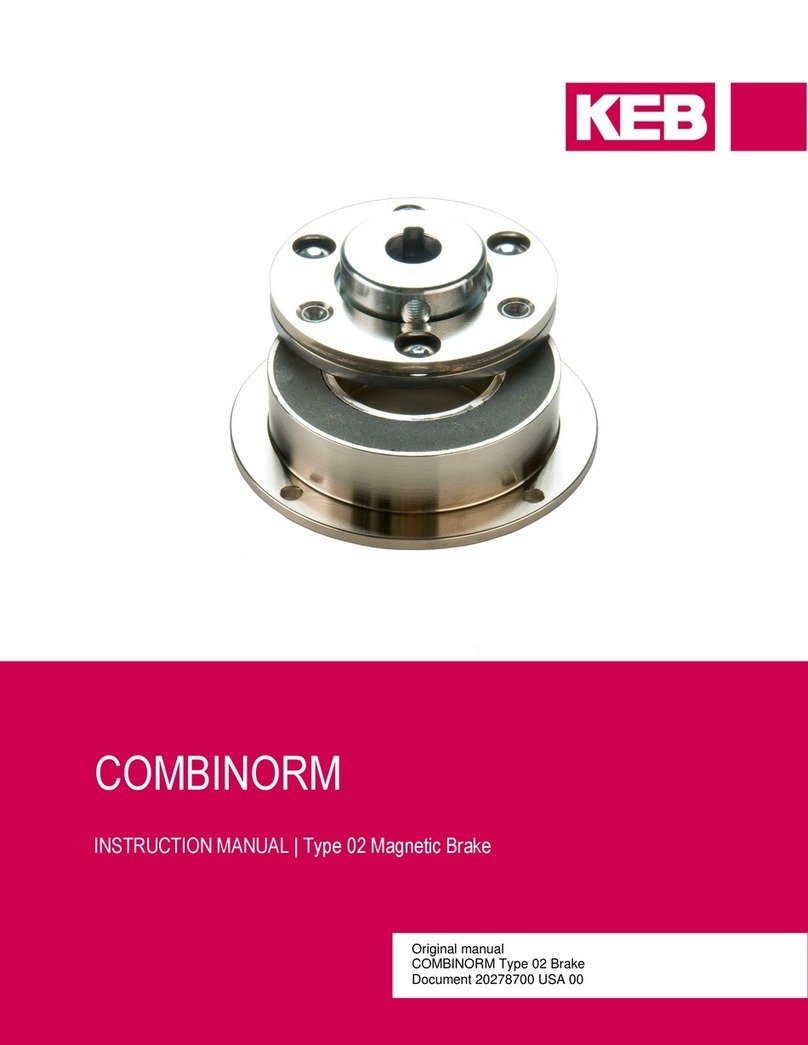
KEBCO
KEBCO COMBINORM User manual
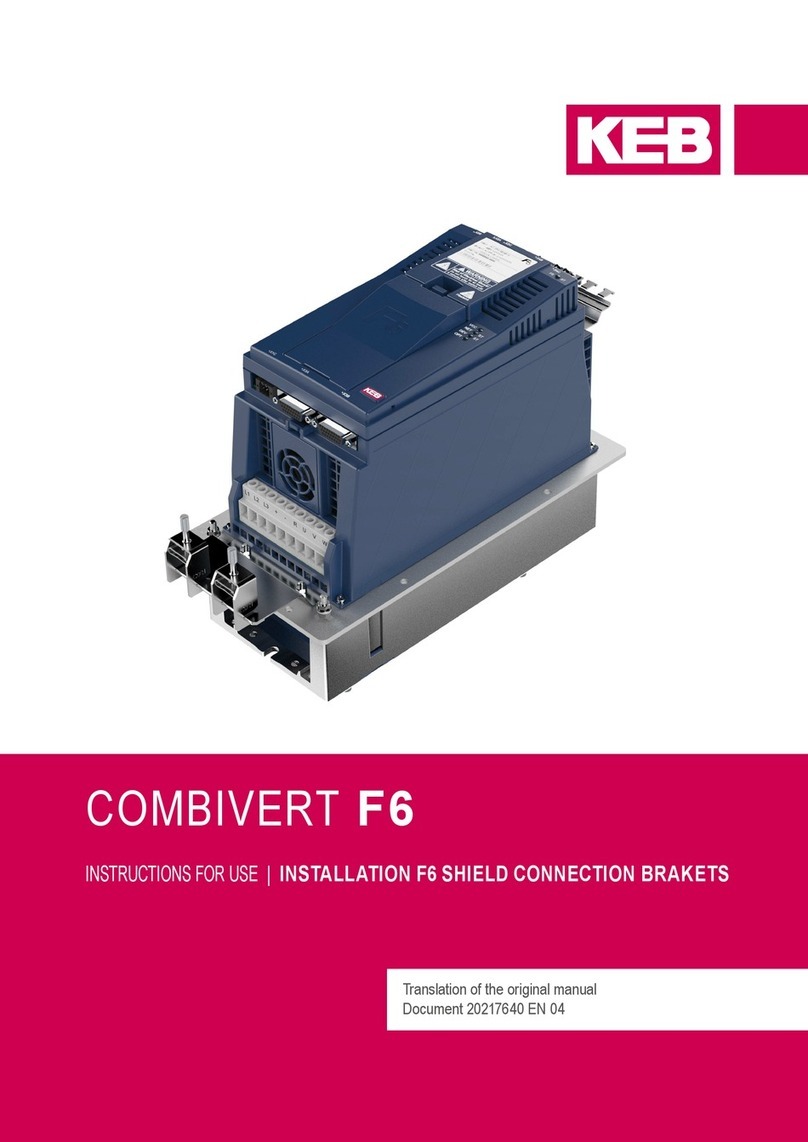
KEBCO
KEBCO COMBIVERT F6 User manual

KEBCO
KEBCO COMBIVERT G6 User manual
